“That was mind boggling!” A woman is whisper-yelling at her husband as they head for the VIP exit at the National Dog Show. “A bonkers decision!” She is, indeed, pissed. This is the most overtly heated exchange I’ve witnessed in my 10 hours (70 hours, in dog time) behind the scenes at the dog show.
She isn’t the only one who’s pissed. The announcement of Best in Show passed in a whisper from stage manager to walkie-talkie, then boomed across the Greater Philadelphia Expo Center in King of Prussia, PA, moving this WASP-packed room to a collective gasp. A woman leans over to her friend to say, “That was a choice.” I notice that the whisper-yelling woman (who is in a floor-length, blue gown) is not quite stomping, but stamping away from the iconic cerulean carpet where the winner was announced. This is the National Dog Show, also known by its Christian name THE NATIONAL DOG SHOW PRESENTED BY PURINA WHERE PEOPLE AND PETS ARE BETTER TOGETHER, and it is an enigma.
Perhaps I should start at the very beginning—when I step into the expo center to find an actual Boy Scout handing out maps of the space. They are useless. Not because the map itself is bad, but because by 10am, this event has already descended into canine chaos and the notion of applying any geographical constraints to the place has become absurd. The two-hour broadcast is filmed on what I eventually will come to nickname God’s Blue Country. If you were one of the 32 million people who watched the National Dog Show on NBC after the Macy’s Thanksgiving Day Parade last year, you may know what I’m talking about. It’s the carpeted stage where the 200 Bests in Breed become seven group winners, before one of them is eventually crowned Best in Show champion. The stage is shrouded in relative darkness, with spotlights that literally make my scalp sweat. A Purina executive with a German accent asks if I want my picture taken with the “Best in Toy Group” sign. I do. What I don’t yet know is that by the end of my day at THE NATIONAL DOG SHOW PRESENTED BY PURINA WHERE PEOPLE AND PETS ARE BETTER TOGETHER, I will understand that toy dogs are not just small dogs. They are a vibe. A way of life, even.
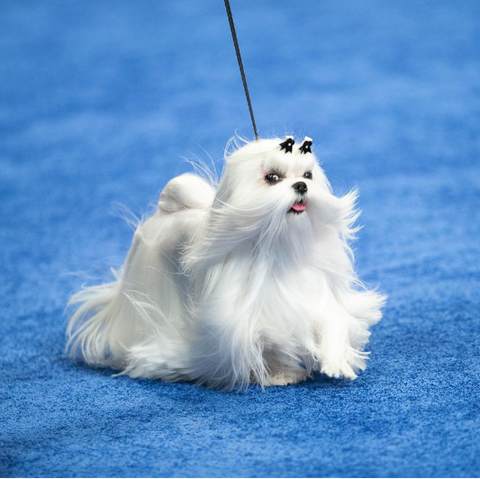
Steve Donahue, See Spot Run Photography
This, I come to learn, is true for each category: the Hounds, the Working Group, the Non-Working Group. All of them. The politics here are real, but they’re between breeds and trainers. This is a vacuum where no one mentions Donald Trump. The closest I get to a discussion of identity politics is how the Golden Retriever—America’s Favorite Dog—has scandalously never won the top title. But those things matter here. There are breeds with attitudes and certain expectations about who deserves to win. Even more mysteriously, the dogs do not compete for a large sum of money or everlasting fame, but simply be the best dog, a particularly doggy form of competition. This pageant that happens in the background while your uncle cracks open his first Budweiser of Thanksgiving is a New American Tradition, and it is a blue-carpeted blessing to behold.
10:00 am
Upon entering, a young, smartly-dressed PR professional for the show gets down to business. She is my Dog Virgil. She briefs me on the day’s events in a Sorkinesque walk-and-talk-fashion. The breed judging takes up most of the day. We pass the Airedale Terriers at a grueling pace. And then group judging begins at 1pm. Underneath the fluorescent lights and exposed rafters, there is a rule of thumb that keeps us from getting swallowed by the crowd (or lost forever behind the shadow of a Bernese Mountain Dog): the outer ring of this purebred purgatory is for vendors selling everything from pet portraits to fried Oreos. The next ring is where legends are born—benching stations where dogs are primped and washed in breed-organized aisles until their moment in the sun. That is when they enter the center-ring: an off-camera judging area where, say, twenty Australian Shepards enter to be assessed. Dogs who ascend from that ring are the chosen pup of their breed, destined for television fame much more prestigious than any reality show can offer.
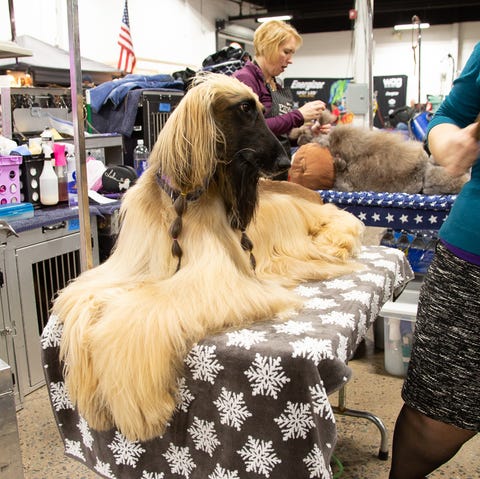
Each breed-specific area has its own personality, with its own attitude. No one longs for a pretzel harder than the American Huskies lined up in their aisle, delighting me with somber mini-howls when a treat walks by. Many of the smaller dogs I approach aren’t allowed to be pet. The same goes for almost any dog with long hair. And the poodles? Well. That whole thing about owners looking like their dogs… is the poodle aisle.
11:00 am
What quickly becomes evident is that the hierarchy of the THE NATIONAL DOG SHOW PRESENTED BY PURINA WHERE PEOPLE AND PETS ARE BETTER TOGETHER has little to do with the dogs. Some people have been professionally breeding for years, and they aren’t shy about letting me know that. And then there are just really great dogs who rise to the top anyway, like Keeper. The first dog I walk up to is a Bernese Mountain Dog, and he’s a giant boy who has buried his face underneath hand-sized paws. Very good boy. I’d even venture to say excellent. Keeper and his owner Elizabeth Fletcher are now the two-year-running Best in Breed champion.
Unlike a lot of the dogs, Keeper is a four-year-old family pet who just happens to have a more impressive resumé than me, including a supporting role as Meatball the Bernese Mountain Dog in the Mark Wahlberg film Instant Family. When I tell Fletcher that I hope Keeper wins, she’s quick to say, “He won’t win.” When I ask why, she simply says, “He just won’t. But we’re fine with that.” I’m mad for Keeper because he’s a great boy who deserves the best in life, but Fletcher makes it clear that this is not his time.
There is a certain zaniness required to thrive in this environment. This, I feel, helps explain why award-winning sports journalist Mary Carillo serves as the show’s lead commentator.
After being approached for the gig while (literally) running to an onsite NBC studio at the 2008 Beijing Olympics, she signed on without hesitation. “I left skid marks,” she tells me. When I round a corner toward the breed competition ring, I find her on the ground, wearing a lab coat, surrounded by a gang of yellow Labrador Retrievers. She is, clearly, doing investigative journalism. According to Carillo, this may or may not have stemmed from a late night, partly-intoxicated segment brainstorm. “The Labrador Retriever is the most popular breed and it never wins Best in Show,” she notes. Why? “The answer required a lab coat. It required a lot of deep research.”
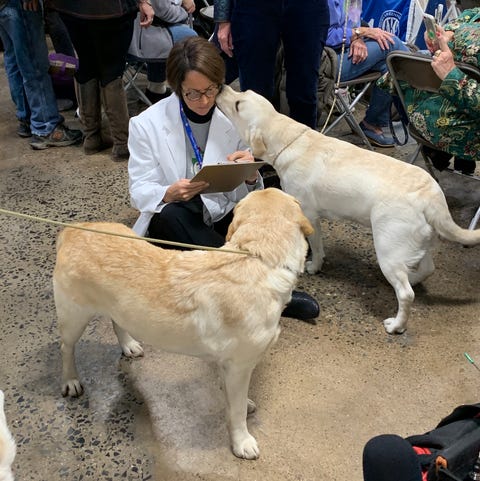
Andrew Eccles
In my view, Labs just aren’t dignified enough. Winners are prestige films. Your Marriage Story, your Parasite.Like a Schnauzer, an Affenpinscher, the Afghan Hound. A Golden or Labrador Retriever is more like a really good Marvel movie. Short of a spider appearing above a booth and writing “SOME DOG” in a web, the Lab is, no offense, too common for consideration.
2:00 pm
Over lunch, I hear that if you want the real intel on the Dog Show, you must find Howard Huber, a master dog handler. I write his name down.
3:00 pm
In my meandering, I get a text telling me that there’s an opportunity to speak to the voice(s) of the event: John O’Hurley and David Frei, the hosts of the National Dog Show for the past 18 years. For anyone who has ever even half-heartedly watched the program, their banter is unmistakable. Frei, who began as a dog handler, then a judge, is an uncontested icon on the dog circuit.

Steve Donahue, See Spot Run Photography
And then there’s O’Hurley, who had a completely different path. He got a call one day from NBC Sports’ Jon Miller after a viewing of the classic Christopher Guest mockumentary Best in Show. Miller, O’Hurley says, wanted to do a televised dog show—not Westminster, but a program that captures the spirit of that film. But don’t be mistaken: THE NATIONAL DOG SHOW, PRESENTED BY PURINA WHERE PEOPLE AND PETS ARE BETTER TOGETHER is not Westminster. That’s like mixing up Daytona and Bristol. Cabarnet Savignon and Merlot. Vivian Banks 1 and Vivian Banks 2. Those may not seem like important distinctions, but the misnomer will have real fans eating you alive. Miller wanted O’Hurley to host this new program, which he initially laughed off. A few days later, he tells me about a call from the NBC Sports exec who simply said, “Woof, woof.” O’Hurley was in.
“Every other piece of entertainment is going down, and everybody is fighting for hundreds of thousands of viewers,” O’Hurley says. “We’re doing Seinfeld numbers.” The first year, the broadcast pulled in a few million viewers. Last year? About 30 million. The pieces—Thanksgiving, Philadelphia, wet noses—were all there.
4:00pm
Upon further encouragement, I start seeking out Huber in earnest. He isn’t just a handler, but a legend of the game. He’s often consulted by other handlers. He’s created his own dynasty of sorts. I finally find his station, but he’s showing another dog on God’s Blue Country. I bide my time and make my way over to the Non-Sporting Group section. One man, who prefers not to give me his name, is wearing a glorious sweater covered in proud Chow Chows. It reads I LOVE MY CHOW CHOWS. Behind him, a ginger-colored Chow Chow shoots me a glare.
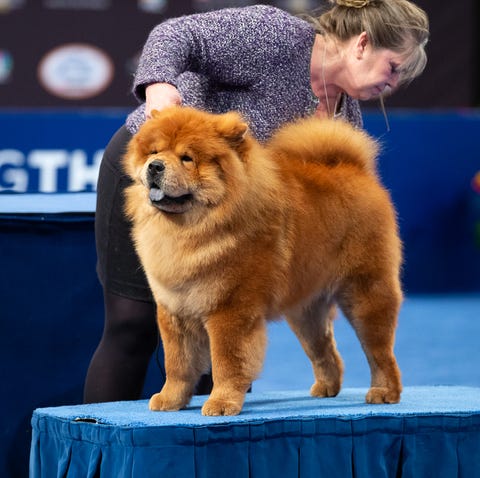
Steve Donahue, See Spot Run Photography
When I ask the man about the community at the National Dog Show, he makes hard eye contact with me, turns to his Chow Chow and fluffs her fur, saying, “The breeds don’t really talk with one another. The Chows don’t talk to the Shar-Peis and they don’t talk to the Bichons.” He stops and widens his eyes, saying, “It’s not that we think any less of one another. There’s just not a reason.” And then he walks away.
Up the aisle from him is 72-year-old Rita Newcomb and her 9-month-old Colton De Tulear, Bella, who looks, basically like a white wig, dropped on a table. Leaning over in a slight whisper, she tells me, “Stay away from all the politics. I don’t support it.” Newcomb has taken up the sport just a few years ago, and she’d prefer to remain free of the complexities of this circuit. I wish her and Bella all my love. I wave goodbye to Bella, and I know she sees me because Newcomb has just affixed a headband to keep the hair out of Bella’s eyes. She seems pleased.
5:00pm
Rikki Knerr, who has just finished wrapping a Springer Spaniel’s ears in bedazzled pink medical tape, is one part of a larger crew. “She had to have sparkles because she’s pretty,” she says, grabbing a spray bottle of leave-in conditioner with the words PLUSH PUPPY on it. “You don’t want them to be big and frizzy, like my hair,” she says, tossing out a section of her own long, curly hair. “So we wrap them.”
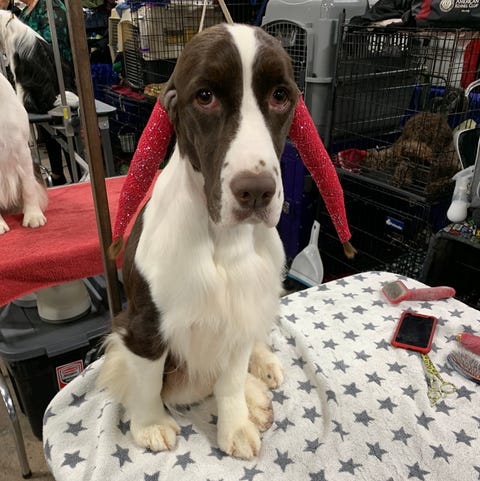
Andrew Eccles
If I’ve heard one refrain all day, it’s that there’s not a lot of money in showing on the dog show circuit. Don’t pour big amounts of money in, and you don’t typically win. Pour in everything, and the winning prize comes with a $20,000 check. At Westminster? A trophy. The hope is that maybe, sponsorships or other paying-deals might come along. Ultimately, it’s a zero-sum sport at best, which is why the long-running legends are the real enigmas.
6:00pm
After hours of mystique, I spot Huber, whom I have, by this time, come to think of as my personal National Dog Show mob boss. Leaning back in a camping chair, he has a big rosy face and a gray pompadour hairdo and a slight drawl. I expect him to say something like, “You come into my booth on the day my dog is to be married and you ask me to do murder.”
For Huber, the whole thing is indeed a family affair. One of his sons is showing at this year’s show, too, and so is his daughter-in-law, who has also been his assistant for years. His youngest son lives in Australia now because he fell in love with another breeder down under. At 57, Huber is a retired member of the Air Force with more time than ever to invest in the show. They travel cross-country in an RV—just him, his wife, and a whole slew of good dogs. “The care of the animals is of the utmost importance,” he says. “You have to make sure you have the right equipment to make sure they’re comfortable and taken care of properly.” For a legend, I am surprised to find his take on all this comfortingly banal. He is the final, evolved form of Dog Show contender—he transcends politics or insecurity. Surprisingly, he is, unlike my friend in the Chow Chow sweatshirt, from the camp of people happy to admit that these are just dogs.
7:00pm
Judging is the barricade that keeps the National Dog Show from being swallowed by its stronger personalities. Tom Coen has been doing it for about 20 years. He specializes in the Herding Group, but he’s also judged Best in Show. For a particular group, the judging criteria is a bit more specific: does a particular dog encompass the best attributes of that group? When it comes to Best in Show, it becomes even more complicated.

Steve Donahue, See Spot Run Photography
Coen says, “Sometimes you’ll have seven really wonderful dogs, and it comes down to the details, and you get down to the actual performance in the moment.” That can come across like a subjective decision, especially when you factor in that someone like Coen has known some of these people for 50 years. But when I ask him about nepotism, he seems borderline offended. Leave accusations of election tampering to the U.S. presidency. This system is pure.
“You have to just close your eyes to that and judge just the dog. That’s the way it is,” he insists. “You have to live with yourself after it’s over and do what pleases you. Sometimes they’ll say, ‘He or she knows her or likes that breed,’ but you know… to not put up the one that you think is the best is crazy.”
8:00pm
Each of the seven Bests in Group are rolled out of God’s Blue Country again. Keeper is gone, like Fletcher predicted. I’m sad, but can’t blame him or Fletcher. The day started with 2,080 dogs. We’re now down to seven. Based on the cheers, there is one clear crowd favorite. There is also one contender who, based on the pup’s record, is more of a statistical likely winner. From listening to side chatter, this particular dog has been the favorite to take the whole show since hour one. The dog is world-ranked, after all. Past wins, world rankings, highly primped fur: those are the stats you need to win. Both pups have passionate backers, and either would be a safe assumption.
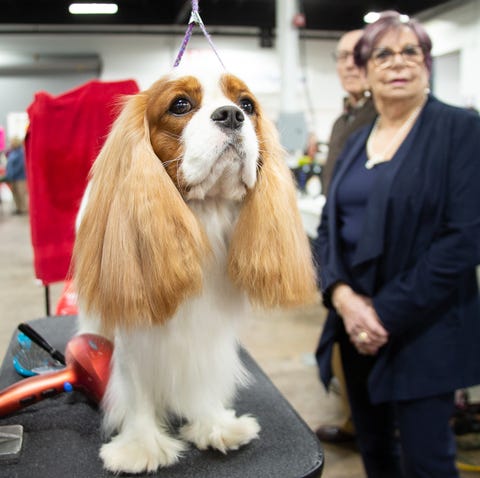
Steve Donahue, See Spot Run Photography
But you know what they say about assuming—it causes women in long, blue dresses to whisper-yell at their husbands. Standing in the darkness, looking out on God’s Blue Country, I hear a producer whisper the actual winner into his walkie-talkie, and it’s apparently so stunning to the person on the other end that he has to repeat it. After this cursory lesson in dog showing, even I question the choice. At this point, the majority of people in this room have been in the expo center for a full 10 hours, just like me. Some of them longer. The decision is announced, and I—I admit—am rooting for full-blown anarchy. I want dogs howling for justice. But after a round of gasps, people just start leaving. They pack their dogs in crates and wheel them out, with one occasionally letting out a quick whimper. I imagine him saying, “It’s not time to go,” in the same way I used to protest leaving Dollywood as a child.
Stomping, stamping, or casually strolling, people file out of The Greater Philadelphia Expo Center. I want them to stay. We just did the whole thing together, but as quickly and chaotically as it all started, it also ends. I’m left standing on the cerulean carpet, waiting to ask hard questions of the winner, but it will never be enough. In this moment, the layers of THE NATIONAL DOG SHOW PRESENTED BY PURINA WHERE PETS AND PEOPLE ARE BETTER OR WHATEVER IT’S CALLED are somehow more confusing than they were the day before. Here, as in human life, only one dog can win. Only one handler. The two of them will be celebrating their victory with beer and extra food for the pup. So shall we all. It is the American way.
Image Source:*COURTESY
Source:esquire.com

